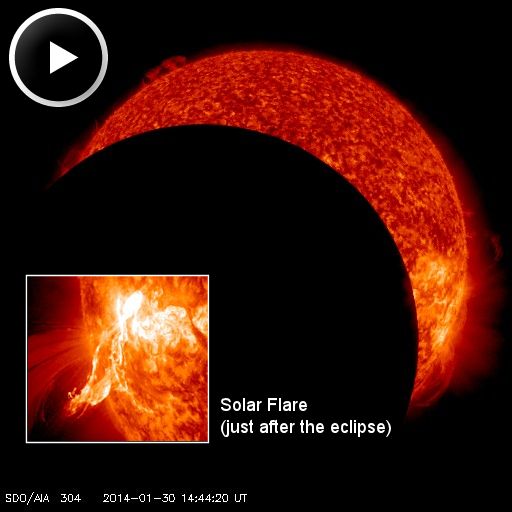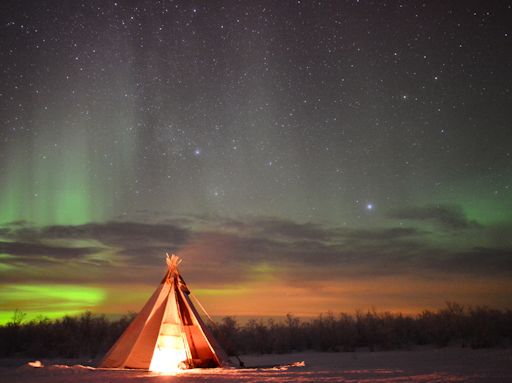Listen to radar echoes from satellites and meteors, live on listener-supported Space Weather Radio. | | | STRONG M-FLARE: Big sunspot AR1967 unleashed a strong M6-class solar flare on Jan. 30th at approximately 1617 UTC. The explosion, which may be seen at the end of this movie of today's solar eclipse, hurled a CME into space. Radio emissions from shock waves preceding the CME suggest that it could be leaving the sun faster than 2100 km/s (4.7 million mph). Stay tuned for updates about this potentially significant event. Solar flare alerts: text, voice LUNAR TRANSIT OF THE SUN: Earlier today, the Moon eclipsed the sun. No one on Earth saw it. The "lunar transit" was only visible from space. NASA's Solar Dynamics Observatory recorded the whole thing from geosynchronous orbit: 
At maximum eclipse as much as 90% of the sun was covered. SDO is solar powered, but it did not "brown out" because mission controllers put an extra charge on the spacecraft's batteries ahead of time. Every year, SDO observes multiple lunar transits. This one, lasting almost 2.5 hours, was the longest in the history of the spacecraft's 4 year mission. Realtime Space Weather Photo Gallery NON-STOP NORTHERN LIGHTS: In Sweden's Abisko National Park, Chad Blakley has been an aurora tour guide for many years. "I believe January 2014 will be remembered as the best aurora watching month of my life!" he says. "Last night, for the 25th time this year, we enjoyed an amazing display of northern lights." He stepped outside his teepee for this comemorative shot: 
"The contrast of green lights in the sky and the red glow of the teepee was fantastic," he says. "Our eight guests really enjoyed photographing the display." "With a little luck," Blakley adds, "tonight will be number 26 for the year." He might get his wish. NOAA forecasters estimate a 40% chance of polar geomagnetic storms on Jan 30th in response to a minor solar wind stream buffeting Earth's magnetic field. Aurora alerts: text, voice Realtime Aurora Photo Gallery
Realtime Supernova Photo Gallery
Every night, a network of NASA all-sky cameras scans the skies above the United States for meteoritic fireballs. Automated software maintained by NASA's Meteoroid Environment Office calculates their orbits, velocity, penetration depth in Earth's atmosphere and many other characteristics. Daily results are presented here on Spaceweather.com. On Jan. 30, 2014, the network reported 10 fireballs.
(10 sporadics) 
In this diagram of the inner solar system, all of the fireball orbits intersect at a single point--Earth. The orbits are color-coded by velocity, from slow (red) to fast (blue). [Larger image] [movies] On Jan. 29, 2014, the network reported 5 fireballs.
(5 sporadics) 
In this diagram of the inner solar system, all of the fireball orbits intersect at a single point--Earth. The orbits are color-coded by velocity, from slow (red) to fast (blue). [Larger image] [movies]
Potentially Hazardous Asteroids ( PHAs) are space rocks larger than approximately 100m that can come closer to Earth than 0.05 AU. None of the known PHAs is on a collision course with our planet, although astronomers are finding new ones all the time. On January 30, 2014 there were potentially hazardous asteroids. Notes: LD means "Lunar Distance." 1 LD = 384,401 km, the distance between Earth and the Moon. 1 LD also equals 0.00256 AU. MAG is the visual magnitude of the asteroid on the date of closest approach. | | The official U.S. government space weather bureau | | | The first place to look for information about sundogs, pillars, rainbows and related phenomena. | | | Researchers call it a "Hubble for the sun." SDO is the most advanced solar observatory ever. | | | 3D views of the sun from NASA's Solar and Terrestrial Relations Observatory | | | Realtime and archival images of the Sun from SOHO. | | | from the NOAA Space Environment Center | | | the underlying science of space weather | | 
